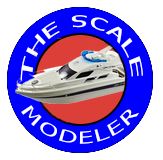The Scale Modeler
 |
| Naam | Omschrijving | Afbeelding |
|---|---|---|
| Cap San Diego | Beautifully detailed and unmatched in the industry, the RC Cap San Diego Freighter is one of our line of historical ships that will not disappoint you. The RC Cap San Diego is Ready to Run (ARTR), with all RC installed to include motors, wiring, rudder servo, transmitter and receiver. Only battery and charger are not included. The ship is carefully handcrafted and assembled using CNC processing to replicate the model as originally as possible. The hull is made from molded GRP complemented by the superstructure and deck which are constructed from laser-cut ABS parts. Many of the small items are made from metal, and almost everything is factory-assembled. The hull, parts of the superstructure, the masts and fittings are spray painted using semi-matt paints. The Cap San Diego is part of the Cap San class of ships that made history in 1962 by ushering in an era of fast freighters with large refrigerated holds and fittings for twelve passengers. With their slim hulls and pronounced stem and stern rakes these ships were more reminiscent of elegant motor-yachts than freighters, and that was why they became known as the White Swans of the South Atlantic. In fact, Cap San Diego and its five sister ships were used by passengers to the Atlantic Passage. Eventually, around 1980, the Container became the dominant means of transporting goods, and the end of the mixed-cargo freighter hove into sight. As a result of this development, the Cap San Diego was sold to Spain in 1981 where it was eventually scrapped in 1986. Rescued from the scrapyard's cutting torch, the Cap San Diego the ship was returned to Hamburg in late 1986, where she was restored mainly by the labor of enthusiasts and laid-off dock workers. The Cap San Diego is currently the world's largest, fast-moving museum cargo ship. Moored at the port of Hamburg, visitors can access virtually all areas of the ship from the bridge to the engine, visit rotating exhibitions in the cargo holds, and even book overnight stays. Several times a year, the ship leaves the harbor for trips along the river Elbe or to the coastal town of Cuxhaven at the mouth of the river. FEATURES •Almost ready-to-run (ARTR) •GRP hull •Superstructure made from laser-cut ABS parts •Details and small parts made from metal •Finely-detailed booms •Semi-matt colors •All decorative decals are factory applied •SPEED 700 class electric motor installed •Simple installation of the RC components INCLUDED •Cap San Diego Freighter •Boat Stand •Small Parts SPECIFICATIONS: LENGTH: 63.5 INCHES WIDTH: 8.5 INCHES WEIGHT: 22.7 SCALE: 1:100 | |
| Emma Maersk Sea Container Ship | LENGTH OVER ALL: 4 FEET 4 INCHES INCHES CONSTRUCTION MATERIALS: EXCEPTIONALLY STRONG FIBERGLASS HULL - SUPERSTRUCTURE IS COPPER AND RESIN SCALE: 1:300 POWER: SHIP IS POWERED BY 1 ELECTRIC MOTORS - DIRECT CURRENT MOTOR MODEL 1 550 POWER SUPPLY: REQUIRES (1) 6 VOLT BATTERY WITH CHARGER - NOT INCLUDED. SPEED: 1 METER/SECOND DURATION OF SHIP OPERATION: APPROXIMATELY 60 - 80 MINUTES @ FULL BATTERY CHARGE - YOUR TIME MAY VARY WITH SPEED UTILIZED RC SYSTEM: INCLUDES 2 CHANNEL DIGITAL SCALE TRANSMITTER/CONTROLLER (REQUIRES AA BATTERIES) SPEED CONTROL: INCLUDES ELECTRONIC SPEED CONTROL (ESC) - INSTALLED | |
| Grand Cayman Oil Tanker | The GRAND CAYMAN is a highly detailed, beautifully constructed, READY TO RUN (RTR) TANKER SHIP 48 inches in length. This is not a fair weather RC ship and will easily take wind and wave. Includes all RC installed. Powered by single engine electric motor. | |
| Great Lake Freighter The Edmund Fitzgerald | An incredibly detailed museum quality ship of the Edmund Fitzgerald. RC Model is 48 inches in length. . When launched on June 8, 1958, SS Edmund Fitzgerald was the largest ship on North America's Great Lakes. Nicknamed the "Mighty Fitz", "Fitz", or "Big Fitz". For seventeen years the Fitzgerald carried taconite iron ore from mines near Duluth, Minnesota, to iron works in Detroit, Toledo, and other Great Lakes ports. As a "workhorse" she set seasonal haul records six times, often beating her own previous record. Her size, record-breaking performance, and "DJ captain" endeared the Fitzgerald to boat watchers. Captain Peter Pulcer was known for piping music day or night over the ship's intercom system while passing through the St. Clair and Detroit Rivers (between Lakes Huron and Erie), and entertaining spectators at the Soo Locks (between Lakes Superior and Huron) with a running commentary about the Fitzgerald. On the afternoon of November 9, 1975, carrying a full cargo of ore pellets, the Edmund Fitzgerald embarked on her voyage from Superior, Wisconsin. En route to a steel mill near Detroit, Michigan, she joined a second freighter, the SS Arthur M. Anderson. By the next day the two ships were caught in the midst of a severe winter storm on Lake Superior, with near hurricane-force winds and waves up to 35 feet high. Shortly after 7:10 p.m. the Fitzgerald suddenly sank in Canadian waters 530 feet deep. Although the Fitzgerald had reported being in difficulty earlier, no distress signals were sent before she sank. Her crew of 29 all perished, and no bodies were recovered. The sinking of the Edmund Fitzgerald is the most famous disaster in the history of Great Lakes shipping, and is the subject of Gordon Lightfoot's hit song, "The Wreck Of The Edmund Fitzgerald." The wreck & sinking of the Edmund Fitzgerald has been a subject fascinating many people. How a storm on Lake Superior could take down a ship that had a length of 2 city blocks with such speed that no distress call could be made? The precise cause of her sinking remains a mystery. Edmund Fitzgerald remained the largest freighter on the great lakes for 17 years, until sunk. ALL RADIO CONTROL equipment installed and ready to go. Battery and charger are NOT included. | |
| Steam Cargo Ship | 54 inches | |





